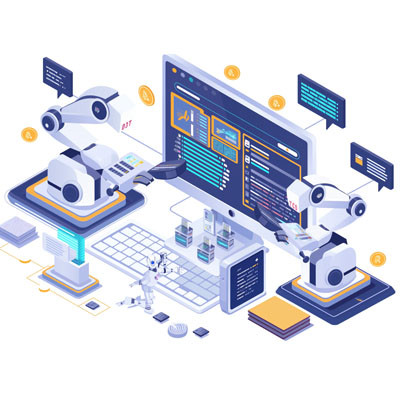Business Automation
As businesses have strict cost considerations to take into account, it is likely that automation will grow in popularity. While perhaps more expensive to initially implement, automated solutions can easily provide a return on investment by clearing schedules of the annoying (if necessary) repetitive tasks that otherwise eat up your human employees’ time. This combination of machine learning and artificial intelligence is known as Robotic Process Automation and enables businesses to greatly reduce how often human employees need to interfere in these tasks.
Some professionals have been hesitant to invest in AI-driven solutions, primarily due to incomplete algorithms and the negative opinion towards “replacing human jobs with robots.” However, artificial intelligence has seen some success in reducing HR costs through its inclusion in some software, and so RPA is experiencing considerable growth.
Furthermore, many of the solutions available today can be used in more simple applications, including the improvement of communications, reducing process inefficiency, and eliminating redundancy.
The Internet of Things
“Smart” devices are quickly becoming the new norm, even in the business environment. Many establishments are directing their budgets toward devices meant to improve security, evaluate utility usage, manage supply chains, and other operations.
The prevailing motivation behind implementing and integrating these devices is simple: better cost control. If a business has the tools to track and manage their costs, the entirety of the business can be better optimized. When fewer resources are expended on a business’ crucial interactions and processes, the business inherently becomes more sustainable.
Various Cloud Services
While it may seem like there has been ample time to take advantage of every aspect of the cloud’s capabilities, new services and utilities are still emerging. Sure, most businesses have adopted the cloud to support their email and file sharing needs, but this is the relative tip of the iceberg as far as the cloud’s potential is concerned. Businesses can now consider options like Infrastructure as a Service (IaaS), Security as a Service (SECaaS), and even AI as a Service (AIaaS), confident in the reliability of these increasingly popular utilities and others.
Cloud vendors are also creating new services to see to a business’ needs. The largest cloud vendors can effectively fill any requirement a business has through increasingly specific services. As a result, SMBs definitely have options to help resolve their operational hurdles.
Cybersecurity Awareness
At this point, there is plenty of precedent to establish -- without any doubt -- that businesses of every size, industry, and resource level need to have a cybersecurity strategy in place. While many may argue that enterprise-grade security solutions are above their means, the aforementioned precedent makes this argument untenable. 66 percent of all SMBs were targeted by some kind of cyberattack in 2019, and 2020 is already projected to be just as bad, if not worse.
Fortunately, there are ways that a business can improve their cybersecurity preparedness, such as:
- Staff training - It is a simple concept: the more able your employees are to spot and properly handle a potential cyberattack (like phishing), the less likely your organization is to be victimized. Security has improved greatly, thanks to methods like encryption, rendering your employees your most vulnerable point. Properly training your staff to identify and report suspected threats, the safer your network will be.
- Threat intelligence - If you know how you are most likely to be attacked, based on the vulnerabilities that cybercriminals usually target, you will be better prepared to handle these attacks. Think of this as the practical application of “knowledge is power.”
- Multi-layering - With all the potential security issues that businesses face today, businesses of all sizes need to have a strategy in place to reduce all risks that face them. Therefore, all businesses and especially small businesses, need to have redundant file backup, DNS protection strategies, and AI/machine learning-enabled security features in place.
Improved Mobility
For the past decade, businesses have struggled with mobilizing their workforce. As a result, with today’s emphasis on remote work and other mobility-related concerns, solutions that enable a mobile workforce while eliminating risk have increased in importance. Now, increased connectivity, improved data security, and data protection policies like Bring Your Own Device (BYOD) allow your operations to be completed from inside and outside of your workplace, with resources safely delivered to your employees as they need them.
Coleman Technologies can help businesses around British Columbia adopt these approaches, or improve their use of them, to assist their operations and boost profitable productivity. To learn more, give us a call at (604) 513-9428.






